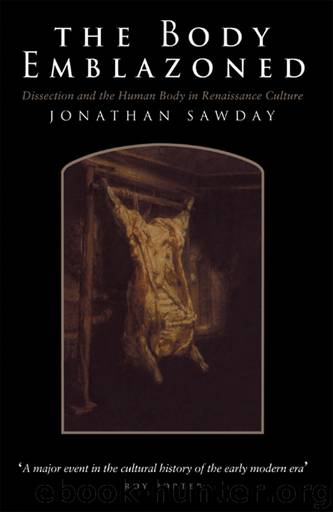The Body Emblazoned by Sawday Jonathan

Author:Sawday, Jonathan. [Sawday, Jonathan]
Language: eng
Format: epub
ISBN: 9781134526420
Publisher: Taylor & Francis (CAM)
‘Now gins this goodly frame of Temperance/Fairely to rise’ Spenser had written at the opening of the Bower of Blisse episode (FQ II.xii.1). For Crooke, just as for Spenser, the body-building, traversed through that Renaissance delight in allegoria, contained a complex economy of functions – a distribution of government throughout the whole edifice which was also the morally and spiritually ‘temperate’ individual who was to be ‘fashioned’ by the poem, and surveyed by the anatomist. The equivalence of this passage from Crooke’s anatomical text with Donne’s wandering through the great cellars and vaults of the human fabric in his sermon is clear. But where Donne’s passage encountered only volume and concavity – a sequence of empty spaces – Crooke’s world is peopled with a consort of inhabitants: the ‘passions’, ruled over by the queen of the whole mansion, the soul. To a seventeenth-century reader, however, the echoes would have been unmistakable. Reading Crooke’s account of the body, they would also have recognized the stately passage of Spenserian stanzas over the text.
Crooke’s allegorical transformation of the body echoes in almost every detail the ‘House of Alma’ passage of The Faerie Queene, which had first appeared in 1590, and then had been republished in 1596, 1609, and 1611. Crooke, in his dismantling of the body, followed the ‘order of dissection’ (moving from stomach, to thorax, to head) which is also the order followed by Spenser’s knights, Arthur and Guyon, as they move through the body which is also a castle. Linguistic parallels between the two texts mirror the structural similarity. Thus, Guyon and Arthur pass from a ‘kitchen-rowme’ (II.ix.28) into the ‘goodly parlour’ of the heart (II.ix.33), just as Crooke led the reader through the ‘cooke-roomes’ into the ‘riche parlour’ of the passions. Within the heart, the ‘lovely bevy of faire Ladies’ bear a passing resemblance to Crooke’s ‘bevy of Damzels’. In Spenser’s castle of Alma, as we have seen, can be found ‘Shamefastnesse it selfe’ (II.ix.43) a figure whom Crooke splits into two individuals: ‘Modest as modesty itselfe’ and ‘another Shamefaste’. Reading Crooke’s description, it is as if the anatomist had an opened copy of The Faerie Queene in front of him rather than either an anatomical text or a cadaver, a suspicion which is confirmed on turning back to Book II of Microcosmographia (‘Of the Whole Bodie and Lower Belly’), where Crooke quotes the famous arithmetic stanza of Spenser’s poem (II.ix.22) as a preface to the anatomical journey he is inviting the reader to undertake:
The Frame thereof seemd partly circulare,
And part triangulare, O work divine;
These two the first and last proportions are,
The one imperfect, mortall, foeminine;
Th’other immortall, perfect, masculine,
And twixt them both a quadrate was the base,
Proportioned equally by seven and nine;
Nine was the circle set in heavens place,
All which compacted made a goodly diapase.
(FQ II.ix 22)
Download
This site does not store any files on its server. We only index and link to content provided by other sites. Please contact the content providers to delete copyright contents if any and email us, we'll remove relevant links or contents immediately.
| Coloring Books for Grown-Ups | Humor |
| Movies | Performing Arts |
| Pop Culture | Puzzles & Games |
| Radio | Sheet Music & Scores |
| Television | Trivia & Fun Facts |
The Social Psychology of Inequality by Unknown(2900)
Make Comics Like the Pros by Greg Pak(2820)
Stacked Decks by The Rotenberg Collection(2773)
Purple Hibiscus by Chimamanda Ngozi Adichie(2579)
The Queen of Nothing by Holly Black(2435)
The Art of Doom by Bethesda(2062)
Life of Elizabeth I by Alison Weir(1960)
Putin's Labyrinth(1933)
The Power of Habit: Why We Do What We Do in Life and Business by Charles Duhigg(1907)
Things Are What You Make of Them: Life Advice for Creatives by Adam J. Kurtz(1788)
Drawing Down the Moon by Margot Adler(1751)
Wall and Piece by Banksy(1749)
Agency by William Gibson(1743)
Teaching to Transgress: Education as the Practice of Freedom (Harvest in Translation) by Bell Hooks(1637)
The Beatles Lyrics by Hunter Davies(1631)
Only What's Necessary: Charles M. Schulz and the Art of Peanuts by Chip Kidd(1620)
Art Of Atari by Tim Lapetino(1597)
The Andy Warhol Diaries by Andy Warhol(1530)
Pop Manga by Camilla D'Errico(1507)
